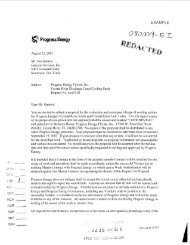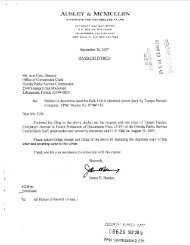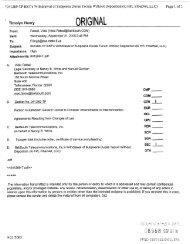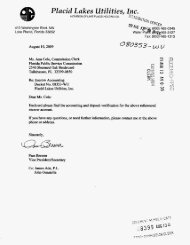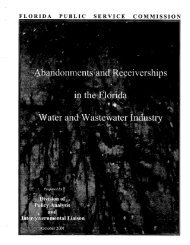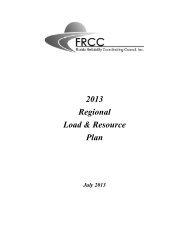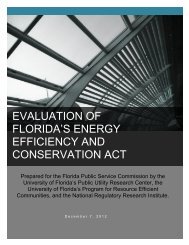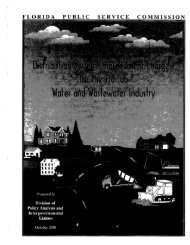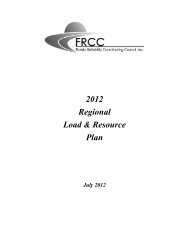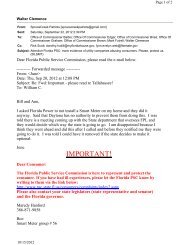Review of 2006 Ten-Year Site Plans - Public Service Commission
Review of 2006 Ten-Year Site Plans - Public Service Commission
Review of 2006 Ten-Year Site Plans - Public Service Commission
Create successful ePaper yourself
Turn your PDF publications into a flip-book with our unique Google optimized e-Paper software.
increases. These program modifications also include greater customer incentives to help maintain the<br />
same level <strong>of</strong> customer participation.<br />
Each February, the <strong>Commission</strong> publishes an annual report describing the utilities’<br />
conservation and DSM activities pursuant to FEECA. 18 Included in the <strong>Commission</strong>’s report is a<br />
summary <strong>of</strong> all utility DSM programs, a comparison <strong>of</strong> current and previous numeric goals, and a<br />
general assessment <strong>of</strong> utility conservation activities. Overall, Florida's utilities have been successful in<br />
meeting the overall objectives <strong>of</strong> FEECA. Since the enactment <strong>of</strong> FEECA, utility conservation<br />
programs have resulted in cumulative statewide peak demand savings <strong>of</strong> 5,332 MW for summer and<br />
5,655 MW for winter, as well as annual energy savings <strong>of</strong> 6,269 GWh for 2007.<br />
Overall, demand and energy savings from utility-sponsored conservation programs are<br />
expected to surpass current goals by as much as 50 percent. Furthermore, the projected average<br />
annual growth rate <strong>of</strong> DSM program savings, as illustrated in Table 4, has increased, reflecting the<br />
effectiveness and success <strong>of</strong> current programs. The <strong>Commission</strong> will continue to explore means <strong>of</strong><br />
cost-effectively increasing the amount <strong>of</strong> DSM savings available from utility conservation programs.<br />
Table 4. Projected Growth Rates <strong>of</strong> DSM Savings<br />
AVERAGE ANNUAL GROWTH RATE (%)<br />
DSM PROGRAM SAVINGS<br />
<strong>2006</strong> 2007<br />
Summer Peak Demand 2.20% 3.01%<br />
Winter Peak Demand 1.62% 2.43%<br />
Net Energy For Load 2.47% 2.93%<br />
DSM programs are projected to increase summer peak demand savings from just over 5,600<br />
MW <strong>of</strong> capacity in 2007 to nearly 7,500 MW <strong>of</strong> capacity in 2016. Similarly, winter peak demand<br />
savings are projected to increase from 6,100 MW <strong>of</strong> capacity in 2007 to over 7,500 MW <strong>of</strong> capacity in<br />
2016. The projected demand savings <strong>of</strong> more than 1,000 MW <strong>of</strong> peak capacity for both summer and<br />
winter are significant in the deferral <strong>of</strong> traditional generation. These savings, in addition to non-peak<br />
demand savings, translate to net energy savings <strong>of</strong> more than 9,000 GWh in 2016, an increase <strong>of</strong> more<br />
than 2,000 GWh over the planning period.<br />
Figures 6, 7, and 8 on the next page illustrate, in greater detail, the projected total amounts <strong>of</strong><br />
annual energy consumption, summer peak demand, and winter peak demand savings from utilitysponsored<br />
DSM programs over the ten-year planning horizon.<br />
18 Annual Report on Activities Pursuant to the Florida Energy Efficiency and Conservation Act, February <strong>2006</strong>.<br />
<strong>Review</strong> <strong>of</strong> 2007 <strong>Ten</strong>-<strong>Year</strong> <strong>Site</strong> <strong>Plans</strong> 18




